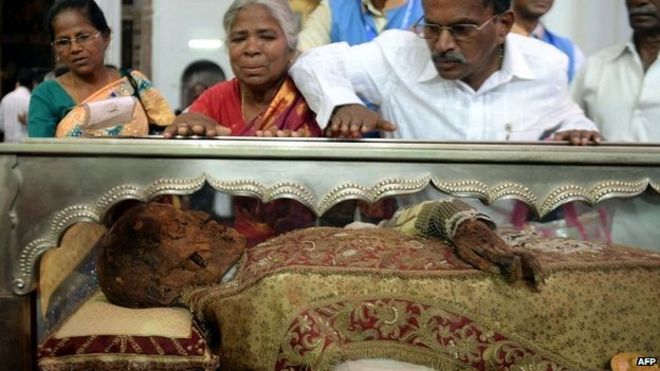
The Tomb of St Francis Xavier
I attended a lecture on March 11 discussing the remains of St Francis Xavier. The lecture talked about the importance of the condition of his body after death and its symbolic nature to how the remains were put on display. The lecture covered detailed pictures of the tomb, the panels, and the pedestal that are hold his body.
Rachel Miller
The lecture was conducted by Rachel Miller. Rachel attended the University of Pittsburgh and she is a PhD candidate. Her research explored St Francis Xavier and his travels spreading Christianity throughout Europe. St Francis Xavier was born in 1506. He studied at the University of Paris in 1525. He began his travels to Rome in 1539 and departed for India in 1541. He later died December 3, 1552. During his lifetime St Francis Xavier initiated missions in much of India, Asia, Malaysia, and Japan, He was the first to create a Christian mission in the area of Japan. He was known as "The Apostle to the Indies,"

Golden Goa
The lecture discussed much about the travels of St Francis Xavier in the Indies. One of the major questions that Rachel asked herself was, "What can representations of Xavier reflect about the region?" It was interesting hearing her discussion the region because there was this image of "Goa Dourada," or Golden Goa which express a wealth and prosperity of Goa. This was an image that represented festivals and an area that was a positive reflection of Christian influence.
The outside of the tomb of St Francis Xavier
The lecture discussed the importance of the trade of silver material among merchants during this time. The panels on the tomb seen above were made of silver. The project of building the sarcophagus for St Francis was directed by Father Marcello Mastrilli. It was discussed, in the lecture, the symbolic nature of the silver in the sarcophagus. The silver panels were symbolic of the depiction of the imagery of Golden Goa. The silver panels showed depictions of St Francis Xavier's travels to sanctify the region. What I found interesting was that the panels could be rearranged which was unlike European pieces before. It was also symbolic that before the body of St Francis Xavier was visible because the silver panels would have been left open. His body was perfectly preserved which symbolized the pureness of Portugal and Christianity unified by showing his (in)corrupt body.

Panel from the sarcophagus of St Francis Xavier
The panels on the sarcophagus were very detailed and lavish in silver. Some images on the panels depicted St Francis Xavier as a supporter but also a protector of the people of Portugal. He was often shown baptizing new followers of Christianity on the panels. In one of those panels it shows him baptizing three Kings who were seen as pagan.

Tomb of St Francis Xavier with pedestal
Later on after the remains of St Francis Xavier began to fall apart, there was attempt to hide the body of St Francis Xavier and the silver panels were closed. After the silver panels had been closed, the sarcophagus was displayed above the viewer in between the viewer and heaven by placing the sarcophagus on a pedestal as seen above. This was an attempt of the Jesuits to take away the attention from the body of St Francis Xavier. The pedestal itself has different symbolism then then original sarcophagus. he pedestal illustrates St Francis Xavier as a universal saint rather than the protector of Portugal. The pedestal contains marble, bronze, and alabaster which are materials that are Florentine. This image takes away from the imagery of Golden Goa that was originally depicted with the silver of the sarcophagus.

St Francis Xavier preaching to followers
It seems to me interesting the combination of materials in the tomb for St Francis Xavier from the original sarcophagus to the pedestal that was later added on. The imagery of the saint in the lecture painted an image of the importance representations that showed people converting under the word of St Francis Xavier. The power in the images was to show the influence of spoken word. The topic of her discussion showing the contrasting views of St Francis Xavier seem to create a contradiction. The original installation showing him as a saint and protector of Portugal and the new installation competing by showing him as a universal represented saint. It brings to mind that if the importance is in showing the influence of his spoken word in conversion to Christianity, then why show views contradicting the view of this great saint. As a viewer the original images of St Francis Xavier and Golden Goa paint a more vivid picture of him as a saint. Knowing the background now it makes me wonder what the images make a viewer think about the region in modern times?
Excellent review of the lecture, Delbert. Isn't it amazing that the Florentine base was commissioned by the Medici? What you mean by "The power in the images was to show the influence of spoken word"?
ReplyDeleteAfter reading your review I now wish I could have attended this lecture. The images are great and what you wrote was very was loaded with so much information. Thank you so much for writing a very interesting review to read.
ReplyDelete